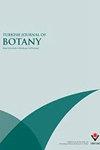Involvement of poly(ADP-ribose)ylation (PARylation) in the regulation of antioxidant defense system in Arabidopsis thaliana under salt stress
IF 1.5
4区 生物学
Q3 PLANT SCIENCES
引用次数: 0
Abstract
: Posttranslational modifications (PTM) are one of the first responses of plants to environmental stress and involve changing the location and activity of proteins in the cell. Addition of poly(ADP-ribose) (PAR) to proteins, poly(ADP-ribose)ylation (PARylation), is a posttranslational modification resulting from the binding of ADP-ribose from NAD + to target proteins by PAR polymerases (PARP). PARylation is involved in many physiological events in plants including abiotic and biotic stress response. The aim of this work was to understand involvement of PARylation in inducing enzymatic antioxidant defence and alternative electron sinks in response to salinity. For this purpose A. thaliana plants were treated with 3-aminobenzamide (3-AB), which is a PARP inhibitor, in the presence of 100 mM NaCl. The 3-AB treatment induced plant fresh weight under control and salinity conditions. Moreover, 100 mM NaCl + 3-AB treated plants had lower lipid peroxidation when compared to 100 mM NaCl group indicating mitigation of oxidative stress. This oxidative stress mitigation was achieved by significantly induced superoxide dismutase (SOD) activity and transcriptional activation of genes related to ROS scavenging such as MSD1 , CAT1 , APX1 , GR1 . On the other hand, transcriptional regulation of mitochondrial alternative oxidase (AOX) pathway was also induced with 3-AB treatment ( AOX1a and AOX1d ) under salt stress indicating that ROS avoidance mechanisms are also activated along with ROS scavenging. However, in contrast to AOX, chloroplastic plastid terminal oxidase pathway was not induced with 3-AB.盐胁迫下拟南芥多(ADP-核糖)酰化(PAR酰化)参与抗氧化防御系统的调控
翻译后修饰(PTM)是植物对环境胁迫的最初反应之一,涉及改变蛋白质在细胞中的位置和活性。将多(ADP-核糖)(标准杆数)添加到蛋白质中,即多(ADP-核糖)酰化(PAR酰化),是由标准杆数聚合酶(PARP)将ADP-核糖从NAD+结合到靶蛋白而引起的翻译后修饰。PAR酰化参与植物的许多生理事件,包括非生物和生物胁迫反应。这项工作的目的是了解PAR酰化在诱导酶促抗氧化防御和响应盐度的替代电子汇中的作用。为此,在100mM NaCl存在下,用作为PARP抑制剂的3-氨基苯甲酰胺(3-AB)处理拟南芥植物。3-AB处理在控制和盐度条件下诱导了植物的鲜重。此外,与100mM NaCl组相比,100mM NaCl+3-AB处理的植物具有较低的脂质过氧化,表明氧化应激的减轻。这种氧化应激缓解是通过显著诱导超氧化物歧化酶(SOD)活性和与ROS清除相关的基因(如MSD1、CAT1、APX1、GR1)的转录激活来实现的。另一方面,在盐胁迫下,3-AB处理(AOX1a和AOX1d)也诱导了线粒体选择性氧化酶(AOX)途径的转录调控,这表明ROS回避机制也随着ROS清除而被激活。然而,与AOX相反,3-AB没有诱导叶绿体质体末端氧化酶途径。
本文章由计算机程序翻译,如有差异,请以英文原文为准。
求助全文
约1分钟内获得全文
求助全文
来源期刊

Turkish Journal of Botany
PLANT SCIENCES-
CiteScore
2.90
自引率
5.60%
发文量
31
审稿时长
6-12 weeks
期刊介绍:
The Turkish Journal of Botany is published electronically 6 times a year by the Scientific and Technological Research Council of Turkey (TÜBİTAK) and accepts manuscripts (in English) covering all areas of plant biology (including genetics, evolution, systematics, structure, function, development, diversity, conservation biology, biogeography, paleobotany, ontogeny, functional morphology, ecology, reproductive biology, and pollination biology), all levels of organisation (molecular to ecosystem), and all plant groups and allied organisms (algae, fungi, and lichens). Authors are required to frame their research questions and discuss their results in terms of major questions in plant biology. In general, papers that are too narrowly focused, purely descriptive, or broad surveys, or that contain only preliminary data or natural history, will not be considered (*).
The following types of article will be considered:
1. Research articles: Original research in various fields of botany will be evaluated as research articles.
2. Research notes: These include articles such as preliminary notes on a study or manuscripts on the morphological, anatomical, cytological, physiological, biochemical, and other properties of plant, algae, lichen and fungi species.
3. Reviews: Reviews of recent developments, improvements, discoveries, and ideas in various fields of botany.
4. Letters to the editor: These include opinions, comments relating to the publishing policy of the Turkish Journal of Botany, news, and suggestions. Letters should not exceed one journal page.
(*) 1. Raw floristic lists (of algae, lichens, fungi, or plants), species descriptions, chorological studies, and plant sociology studies without any additional independent approaches.
2. Comparative morphology and anatomy studies (that do not cover a family, tribe, subtribe, genus, subgenus, section, subsection, or species complexes with taxonomical problems) without one or more independent additional approaches such as phylogenetical, micromorphological, chromosomal and anatomical analyses.
3. Revisions of family, tribe, genus, subgenus, section, subsection, or species complexes without any original outputs such as taxonomical status changes, IUCN categories, and phenological and ecological analyses.
4. New taxa of all plants without any additional independent approaches such as phylogenetical, ecological, chromosomal, chorological and correlational analyses in addition to a detailed macro- and micro-morphological descriptions with quality field and microscopic illustrations of taxonomically important structures and identification key in the taxonomic group.
New records of all plants without any additional independent approaches such as phylogenetical, ecological, chromosomal, chorological and correlational analyses in addition to a detailed macro- and micro-morphological descriptions with quality field and microscopic illustrations of taxonomically important structures and identification key in the taxonomic group may be accepted for peer review if they contain 3 or more new records or taxonomical status update, such as lectotypification, new combinations, transfers, revivals and synonyms.
5. New taxa of algae, lichens, and fungi without any additional independent approaches such as phylogenetical, ecological, chromosomal, chorological and correlational analyses in addition to a detailed macro- and micro-morphological descriptions with quality field and microscopic illustrations of taxonomically important structures and identification key in the taxonomic group.
New records of algae, lichens, and fungi without any additional independent approaches such as phylogenetical, ecological, chromosomal, chorological and correlational analyses in addition to a detailed macro- and micro-morphological descriptions with quality field and microscopic illustrations of taxonomically important structures and identification key in the taxonomic group may be accepted for peer review if they contain 5 or more new records or taxonomical status update, such as lectotypification, new combinations, transfers, revivals and synonyms.
 求助内容:
求助内容: 应助结果提醒方式:
应助结果提醒方式:


